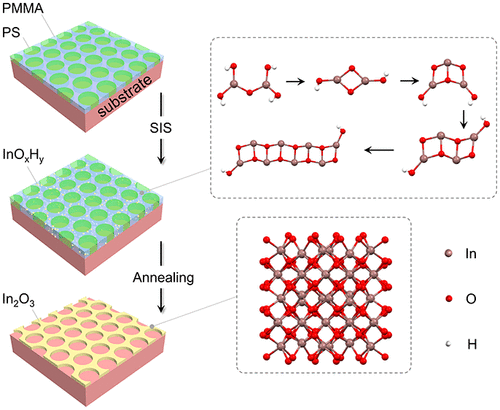Our official English website, www.x-mol.net, welcomes your
feedback! (Note: you will need to create a separate account there.)
Resolving the Atomic Structure of Sequential Infiltration Synthesis Derived Inorganic Clusters
ACS Nano ( IF 15.8 ) Pub Date : 2020-11-10 , DOI: 10.1021/acsnano.0c03848 Xiang He , Ruben Z. Waldman 1 , David J. Mandia , Nari Jeon , Nestor J. Zaluzec , Olaf J. Borkiewicz , Uta Ruett , Seth B. Darling 1 , Alex B. F. Martinson , David M. Tiede
ACS Nano ( IF 15.8 ) Pub Date : 2020-11-10 , DOI: 10.1021/acsnano.0c03848 Xiang He , Ruben Z. Waldman 1 , David J. Mandia , Nari Jeon , Nestor J. Zaluzec , Olaf J. Borkiewicz , Uta Ruett , Seth B. Darling 1 , Alex B. F. Martinson , David M. Tiede
Affiliation

|
Sequential infiltration synthesis (SIS) is a route to the precision deposition of inorganic solids in analogy to atomic layer deposition but occurs within (vs upon) a soft material template. SIS has enabled exquisite nanoscale morphological complexity in various oxides through selective nucleation in block copolymers templates. However, the earliest stages of SIS growth remain unresolved, including the atomic structure of nuclei and the evolution of local coordination environments, before and after polymer template removal. We employed In K-edge extended X-ray absorption fine structure and atomic pair distribution function analysis of high-energy X-ray scattering to unravel (1) the structural evolution of InOxHy clusters inside a poly(methyl methacrylate) (PMMA) host matrix and (2) the formation of porous In2O3 solids (obtained after annealing) as a function of SIS cycle number. Early SIS cycles result in InOxHy cluster growth with high aspect ratio, followed by the formation of a three-dimensional network with additional SIS cycles. That the atomic structures of the InOxHy clusters can be modeled as multinuclear clusters with bonding patterns related to those in In2O3 and In(OH)3 crystal structures suggests that SIS may be an efficient route to 3D arrays of discrete-atom-number clusters. Annealing the mixed inorganic/polymer films in air removes the PMMA template and consolidates the as-grown clusters into cubic In2O3 nanocrystals with structural details that also depend on SIS cycle number.
中文翻译:

解析顺序渗透合成衍生的无机团簇的原子结构
顺序渗透合成(SIS)是类似于原子层沉积的无机固体精确沉积途径,但发生在软材料模板内(相对于软材料模板)。SIS通过在嵌段共聚物模板中进行选择性成核,已使各种氧化物具有出色的纳米级形态复杂性。然而,SIS增长的早期阶段仍未解决,包括去除聚合物模板前后的原子核结构和局部配位环境的演变。我们利用In-Kedge扩展X射线吸收精细结构和高能X射线散射的原子对分布函数分析来揭示(1)InO x H y的结构演变聚甲基丙烯酸甲酯(PMMA)基质内部的簇状结构和(2)多孔In 2 O 3固体(退火后获得)的形成与SIS循环数的关系。早期的SIS周期导致高纵横比的InO x H y团簇生长,然后形成带有附加SIS周期的三维网络。可以将InO x H y团簇的原子结构建模为具有与In 2 O 3和In(OH)3的键合模式有关的键合模式的多核团簇晶体结构表明,SIS可能是通往离散原子数簇的3D阵列的有效途径。在空气中对混合的无机/聚合物薄膜进行退火会去除PMMA模板,并将成簇的簇固结为立方In 2 O 3纳米晶体,其结构细节也取决于SIS循环数。
更新日期:2020-11-25
中文翻译:

解析顺序渗透合成衍生的无机团簇的原子结构
顺序渗透合成(SIS)是类似于原子层沉积的无机固体精确沉积途径,但发生在软材料模板内(相对于软材料模板)。SIS通过在嵌段共聚物模板中进行选择性成核,已使各种氧化物具有出色的纳米级形态复杂性。然而,SIS增长的早期阶段仍未解决,包括去除聚合物模板前后的原子核结构和局部配位环境的演变。我们利用In-Kedge扩展X射线吸收精细结构和高能X射线散射的原子对分布函数分析来揭示(1)InO x H y的结构演变聚甲基丙烯酸甲酯(PMMA)基质内部的簇状结构和(2)多孔In 2 O 3固体(退火后获得)的形成与SIS循环数的关系。早期的SIS周期导致高纵横比的InO x H y团簇生长,然后形成带有附加SIS周期的三维网络。可以将InO x H y团簇的原子结构建模为具有与In 2 O 3和In(OH)3的键合模式有关的键合模式的多核团簇晶体结构表明,SIS可能是通往离散原子数簇的3D阵列的有效途径。在空气中对混合的无机/聚合物薄膜进行退火会去除PMMA模板,并将成簇的簇固结为立方In 2 O 3纳米晶体,其结构细节也取决于SIS循环数。









































 京公网安备 11010802027423号
京公网安备 11010802027423号